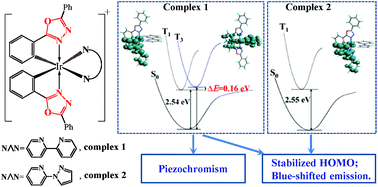Blue-green emitting cationic iridium complexes with 1,3,4-oxadiazole cyclometallating ligands: synthesis, photophysical and electrochemical properties, theoretical investigation and electroluminescent devices†
Abstract
Two cationic iridium complexes, namely [Ir(dph-oxd)2(bpy)]PF6 (1) and [Ir(dph-oxd)2(pzpy)]PF6 (2), using 2,5-diphenyl-1,3,4-oxadiazole (dph-oxd) as the cyclometallating ligand and 2,2′-bipyridine (bpy) or 2-(1H-pyrazol-1-yl)pyridine (pzpy) as the ancillary ligands, have been synthesized, and their photophysical and electrochemical properties have been comprehensively investigated. In solution, both complexes emit efficient blue-green light. For complex 1, the light emission in a neat film is remarkably red-shifted; in solid state, it gives an intriguing piezochromic phenomenon. Compared with archetype [Ir(ppy)2(bpy)]PF6 (ppy is 2-phenylpyridine), complex 1 shows a largely stabilized HOMO (highest occupied molecular orbital) level, induced by the electron-deficient 1,3,4-oxadiazole (oxd) heterocycle of dph-oxd, which results in an enlarged energy gap and blue-shifted emission. Compared with complex 1, complex 2 shows an enhanced LUMO (lowest unoccupied molecular orbital) level, caused by the electron-rich pzpy ancillary ligand, but they exhibit similar emission energy in solution. For both complexes, theoretical calculations reveal that their blue-green emission in solution arises primarily from the 3π–π* states centered on dph-oxd; moreover, complex 1 bears close-lying 3π–π* and 3CT (charge-transfer) states, underlying its remarkably red-shifted emission in the neat film and unique piezochromic behavior in the solid state. Solid state light emitting electrochemical cells (LECs) based on complexes 1 and 2 give efficient yellow and green-blue light, with peak current efficiencies of 18.3 and 5.2 cd A−1, respectively. It is demonstrated that oxd-type cyclometallating ligands are promising as an avenue to stabilize the HOMOs and tune emission properties of cationic iridium complexes to a large extent.


 Please wait while we load your content...
Please wait while we load your content...